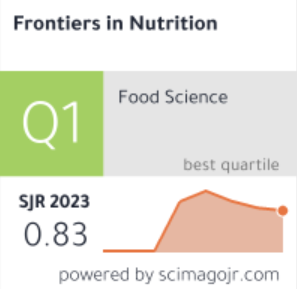使用可穿戴相机客观评估加纳城乡家庭共用盘子进食的情况
IF 4
2区 农林科学
Q2 NUTRITION & DIETETICS
引用次数: 0
摘要
背景在许多中低收入国家(LMICs),共餐(SPE)是指两个或两个以上的人直接用同一个盘子或碗吃饭,是一种常见的家庭食物消费习惯。有关家庭参与 SPE 的研究在很大程度上仍未得到探讨,这凸显了在解释从这些环境中获得的膳食信息时存在的研究空白。对 SPE 研究的缺乏可归因于传统膳食评估方法的固有局限性,这限制了其在 SPE 常见的环境中的可用性。在这篇说明性文章中,我们描述了加纳等低收入和中等收入国家的 SPE 情况,并使用可穿戴相机(自动摄入监测仪 2 版:AIM-2)比较了农村和城市家庭中不同家庭成员进行 SPE 和单盘进食(IPE)的频率。方法采用目的性便利抽样,从加纳的一个城市社区和一个农村社区(n = 60 户)各招募和登记了 30 户家庭。被选中的家庭成员将 AIM-2 佩戴在眼镜框上,为期 3 天。佩戴 AIM-2 后,它能自动收集图像,捕捉参与者所处环境中的食物消费情况,从而被动捕捉家庭 SPE 动态。常见的SPE动态包括只有成人分享、成人和儿童分享、只有儿童分享以及非家庭成员参与SPE。在以 SPE 为常态的环境中,获得可靠、准确的数据对于评估膳食摄入量至关重要。本文章由计算机程序翻译,如有差异,请以英文原文为准。
Objective assessment of shared plate eating using a wearable camera in urban and rural households in Ghana
BackgroundShared plate eating (SPE), defined as two or more individuals eating directly from the same plate or bowl, is a common household food consumption practice in many Low- and Middle-Income Countries (LMICs). Examination of household engagement in SPE remains largely unexplored, highlighting a gap in research when interpreting dietary information obtained from these settings. The dearth of research into SPE can be attributed to the inherent limitations of traditional dietary assessment methods which constrain their usability in settings where SPE is common.ObjectiveIn this expository narrative, we describe what SPE is when it is practiced in an LMIC such as Ghana; and also compare the frequency of SPE versus individual plate eating (IPE) by different household members in rural and urban households using a wearable camera (Automatic Ingestion Monitor version 2: AIM-2).MethodsPurposive convenience sampling was employed to recruit and enroll 30 households each from an urban and a rural community (n = 60 households) in Ghana. The AIM-2 was worn on eyeglass frames for 3 days by selected household members. The AIM-2, when worn, automatically collects images to capture food consumption in participants’ environments, thus enabling passive capture of household SPE dynamics.ResultsA higher percentage of SPE occasions was observed for rural (96.7%) compared to urban (36.7%) households (p < 0.001). Common SPE dynamics included only adults sharing, adults and children sharing, only children sharing, and non-household member participation in SPE.ConclusionThe wearable camera captured eating dynamics within households that would have likely been missed or altered by traditional dietary assessment methods. Obtaining reliable and accurate data is crucial for assessing dietary intake in settings where SPE is a norm.
求助全文
通过发布文献求助,成功后即可免费获取论文全文。
去求助
来源期刊

Frontiers in Nutrition
Agricultural and Biological Sciences-Food Science
CiteScore
5.20
自引率
8.00%
发文量
2891
审稿时长
12 weeks
期刊介绍:
No subject pertains more to human life than nutrition. The aim of Frontiers in Nutrition is to integrate major scientific disciplines in this vast field in order to address the most relevant and pertinent questions and developments. Our ambition is to create an integrated podium based on original research, clinical trials, and contemporary reviews to build a reputable knowledge forum in the domains of human health, dietary behaviors, agronomy & 21st century food science. Through the recognized open-access Frontiers platform we welcome manuscripts to our dedicated sections relating to different areas in the field of nutrition with a focus on human health.
Specialty sections in Frontiers in Nutrition include, for example, Clinical Nutrition, Nutrition & Sustainable Diets, Nutrition and Food Science Technology, Nutrition Methodology, Sport & Exercise Nutrition, Food Chemistry, and Nutritional Immunology. Based on the publication of rigorous scientific research, we thrive to achieve a visible impact on the global nutrition agenda addressing the grand challenges of our time, including obesity, malnutrition, hunger, food waste, sustainability and consumer health.
 求助内容:
求助内容: 应助结果提醒方式:
应助结果提醒方式:


